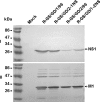The NS1 gene contributes to the virulence of H5N1 avian influenza viruses
- PMID: 16971424
- PMCID: PMC1642184
- DOI: 10.1128/JVI.00993-06
The NS1 gene contributes to the virulence of H5N1 avian influenza viruses
Abstract
In the present study, we explored the genetic basis underlying the virulence and host range of two H5N1 influenza viruses in chickens. A/goose/Guangdong/1/96 (GS/GD/1/96) is a highly pathogenic virus for chickens, whereas A/goose/Guangdong/2/96 (GS/GD/2/96) is unable to replicate in chickens. These two H5N1 viruses differ in sequence by only five amino acids mapping to the PA, NP, M1, and NS1 genes. We used reverse genetics to create four single-gene recombinants that contained one of the sequence-differing genes from nonpathogenic GS/GD/2/96 and the remaining seven gene segments from highly pathogenic GS/GD/1/96. We determined that the NS1 gene of GS/GD/2/96 inhibited the replication of GS/GD/1/96 in chickens, while the substitution of the PA, NP, or M gene did not change the highly pathogenic properties of GS/GD/1/96. Conversely, of the recombinant viruses generated in the GS/GD/2/96 background, only the virus containing the NS1 gene of GS/GD/1/96 was able to replicate and cause disease and death in chickens. The single-amino-acid difference in the sequence of these two NS1 genes resides at position 149. We demonstrate that a recombinant virus expressing the GS/GD/1/96 NS1 protein with Ala149 is able to antagonize the induction of interferon protein levels in chicken embryo fibroblasts (CEFs), but a recombinant virus carrying a Val149 substitution is not capable of the same effect. These results indicate that the NS1 gene is critical for the pathogenicity of avian influenza virus in chickens and that the amino acid residue Ala149 correlates with the ability of these viruses to antagonize interferon induction in CEFs.
Figures



References
-
- Chen, H., K. Yu, and Z. Bu. 1999. Molecular analysis of hemagglutinin gene of a goose origin highly pathogenic avian influenza virus. Chin. Agric. Sci. 32:87-92.
-
- Chen, H., G. J. D. Smith, S. Y. Zhang, K. Qin, J. Wang, K. S. Li, R. G. Webster, J. S. M. Peiris, and Y. Guan. 2005. Avian flu: H5N1 virus outbreak in migratory waterfowl. Nature 436:191-192. - PubMed
Publication types
MeSH terms
Substances
LinkOut - more resources
Full Text Sources
Other Literature Sources
Medical
Miscellaneous

